appx. 1,000 appx. 2,000 | Date 16 May 1771 | |
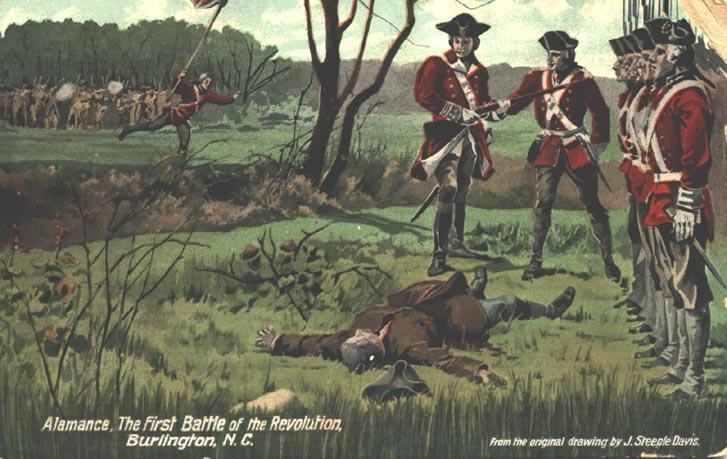 | ||
Result Decisive government victory Similar War of the Regulation, Battle of Moore's Creek Bri, Battle of Guilford Court Ho, Battle of Lindley's Mill, Pyle's Massacre | ||
The Battle of Alamance was the final battle of the War of the Regulation, a rebellion in colonial North Carolina over issues of taxation and local control. Some historians in the late nineteenth-early twentieth centuries considered the battle to be the opening salvo of the American Revolution, and locals agreed with this assessment. Yet, this has been questioned by present-day historians arguing that the Regulators (though viewed in the eyes of the royal governor and his allies as being in rebellion against King, country, and law) were not intending a complete overthrow of His Majesty's Government in North Carolina. They were only standing up against those certain local officials who had become corrupt and unworthy tools of the King, and they only turned to riot and armed rebellion as a last resort when all other peaceful means through petitions, elections to the Assembly, etc. had failed to redress their grievances. Many surviving ex-Regulators became loyalists during the Revolution, and several anti-Regulators [e.g. William Hooper, Alexander Martin, and Francis Nash] became patriots during the Revolution. Named for nearby Great Alamance Creek, the battle took place in what was then Orange County and has since become Alamance County in the central Piedmont about six miles south of present-day Burlington, North Carolina.
Contents
- Horn in the west battle of alamance
- Events prior to the battle
- Course of the battle
- Colonial Militia
- Regulators
- Memorial
- References
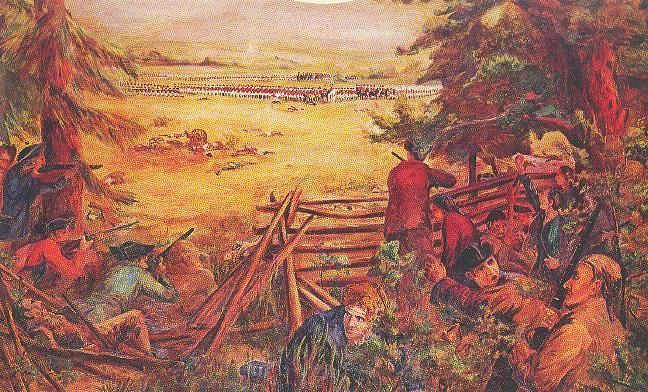
Horn in the west battle of alamance
Events prior to the battle
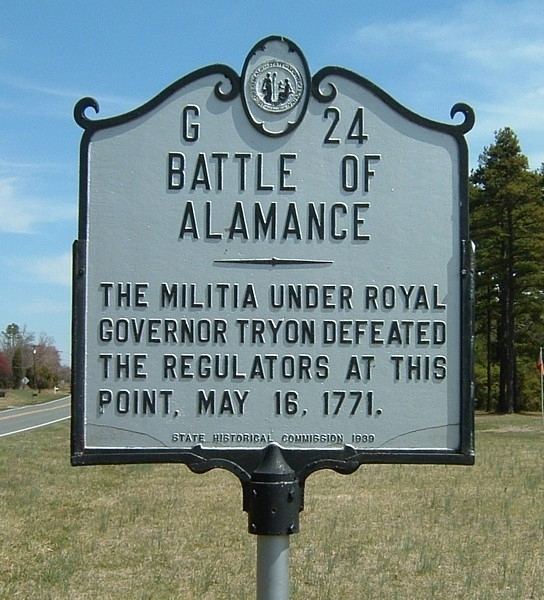
In the spring of 1771, Royal Governor William Tryon left New Bern, mustering and marching approximately 1,000 militia troops west to address a rebellion that had been brewing in western counties for several years, but which had included only minor, scattered acts of violence, followed by refusals to pay fees, disruptions of court proceedings, and continued harassment of government officials. About 2,000 so-called "regulators" had gathered, hoping to gain concessions from the Governor by intimidating him with a show of superior force. Funded by council member and wealthy merchant Samuel Cornell for £6,000, on May 11, Tryon left the county seat of Hillsborough with his militia to confront the Regulators, who had made camp south of Great Alamance Creek in western Orange County (present-day Alamance County).
Course of the battle

On the evening of May 15, Tryon received word that the Regulators were camped about six miles away. The next morning, at about 8:00 am, Tryon's troops set out to a field about one-half mile from the camp of the Regulators. He formed two lines, and divided his artillery between the wings and the center of the first line. The Regulators remained disorganized, with no leadership – no officer ranked higher than captain – and no anticipation of an attack, expecting that their superior numbers would frighten Tryon's militia.
Tryon sent one of his aides-de-camp, Captain Philmore Hawkins, and the Sheriff of Orange County with a proclamation:
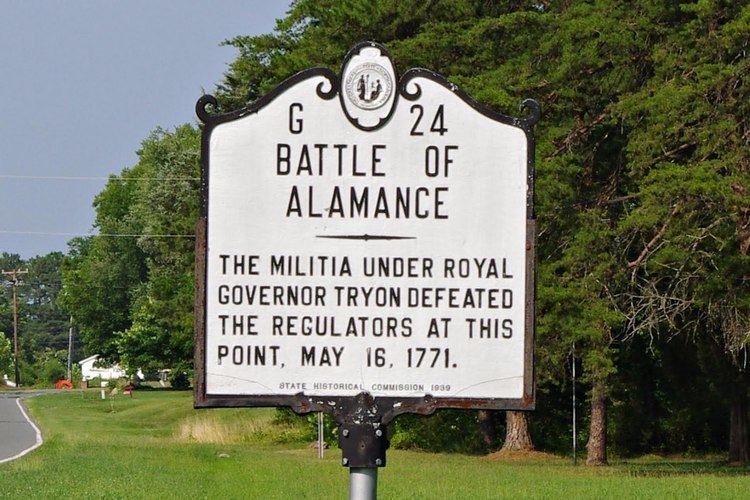
While the terms were being read, Tryon's troops began to move forward. Shortly after that, Tryon was informed that the Regulators had rejected his terms. Herman Husband, a Quaker, realizing violence was about to take place, left the area.
By midday the hour had expired. Tryon sent one final warning:

Some of the Regulators petitioned the Royal Governor to give up seven captured Regulators in exchange for two of his men that they had captured the previous day. Tryon agreed, but after a half an hour, the captured officers did not appear. He became suspicious that his positions were being flanked and ordered the militia to march within 30 yards of the Regulators. Shortly thereafter, a large crowd of Regulators appeared in front of the militia, waving their hats and daring the militia to open fire.
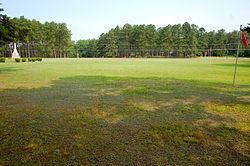
At about this time, two men who had been attempting to negotiate a peace between the two sides left Tryon's camp: Reverend Caldwell and Robert Thompson. Caldwell made it to the field between the two lines, but was warned by the Regulators, who saw that the Governor was about to open fire. Thompson was detained by Tryon as a prisoner. Tryon, in a moment of anger, took a musket from a militiaman and shot Thompson dead. Realizing what he had done, he sent a flag bearer named Donald Malcolm with a white flag in hopes of calming things quickly. The flag bearer was himself fired upon by the Regulators, who called out, "Fire and be damned".
The Regulators lacked the leadership, organization, and ammunition that Tryon had, but the early course of the battle went well for them. They employed what was referred to as "Indian style" fighting, hiding behind trees and avoiding structure and lines. This allowed two of the Regulators, brothers named McPherson, to capture one of Tryon's three cannons. Unfortunately for them, the Regulators had no ammunition and it could not be used.
A man considered one of the principal military leaders of the Regulators, Captain Montgomery, was killed by a shell at about the same time a bullet hit Tryon's hat. The Governor sent a second white flag, but the aide-de-camp was killed while regulator Patrick Muller called for his fellow insurgents to cease fire. Outraged at the disregard of a second white flag, the Governor rallied his troops against the insurgents, whose ammunition was running out. Many of the Regulators fled the field. Delays prevented the 300 reinforcements under Captain Benjamin Merrill from arriving in time. Some of the Regulators remained behind to continue firing upon the milita. Tryon then ordered the woods to be set on fire.
Losses for both sides are disputed. Tryon reported nine dead and 61 wounded among the militia. Other historians indicate much greater numbers, between 15 and 27 killed. Both sides counted nine dead among the Regulators and from dozens to over one-hundred wounded.
Tryon took 13 prisoners. One of them, James Few, was executed at the camp, and six were executed later in nearby Hillsborough. Many Regulators traveled on to frontier areas beyond North Carolina. The Royal Governor pardoned others and allowed them to stay on the condition that they pledge an oath of allegiance to the royal government.
The battle took place in what was then Orange County. During the American Revolution a decade later, the same section of Orange County (subdivided into Alamance County in 1849) saw several minor skirmishes, including the infamous Pyle's Hacking Match in 1781. Recent archaeological studies at the site have shown that the area now known as Alamance Battleground was also the site of another skirmish in the revolutionary war and of a civil war era Confederate encampment.
Colonial Militia
According to Tryon's journal, the following men served under his command:
Regulators
The following individuals were numbered as members of the Regulators:
The following were excepted from pardons by Tryon:
Six men were found guilty of treason, but were pardoned at Tryon's behest:
Six men were found guilty of treason and were sentenced to be hanged, drawn and quartered, although in practice, they were only hanged:
Memorial
Visitors to Alamance Battleground State Historic Site may view the field of battle, memorialized in 1880 with a granite monument and a second monument in 1903. Today the site contains exhibits, period cannon, and colored flags representing troop positions. The visitors' center offers exhibits, artifacts, and a presentation on the battle. Visitors may also tour the onsite Allen House, a restored frontier farmstead of the period.
